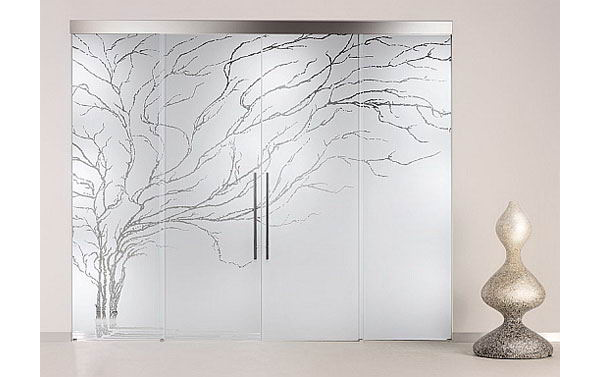Frosted glass
En
Frost glass is ordinary glass that has been specially treated to reduce transparency. Matting methods can be different:
- chemical treatment, or etching. Typically, compositions based on hydrofluoric acid are used for this, a potent reagent that destroys the surface layer of glass;
- sandblasting. A powerful jet of tiny sand is directed onto the surface of the glass sheet, leaving microscopic scratches that form a matte surface;
- gluing matting films. This is the easiest and cheapest way to get frosted glass, but its decorative properties will be somewhat worse.
Depending on what kind of glass was taken for processing, the resulting frosted glass is colorless, with a slight milky tint, or colored. If certain areas of the glass surface are protected from matting, a decorative pattern is formed on the surface of the frosted glass. This technique is used by designers to get interesting visual effects. Frosted glass can be of different sizes and can also be curved.
Frosted glass is widely used for glazing interior doors, as it allows enough light to pass through, and at the same time hides what is happening inside the room from prying eyes. Frosted glass is used for glazing kitchen cabinets, wardrobes and other furniture.
When deciding to use frosted glass, you must take into account that this type of glass is the most difficult to maintain. Grease stains, fingerprints and other contaminants are clearly visible on it, but they are not easy to remove. The chemical compositions of some household products can ruin glass; it is best to use folk remedies - water acidified with vinegar or laundry soap. In addition, it cannot be washed with hot water, otherwise streaks will appear on the surface.
If certain areas of the glass surface are protected from matting, a decorative pattern is formed on the surface of the frosted glass. This technique is used by designers to get interesting visual effects. Frosted glass can be of different sizes and can also be curved.
Frosted glass is widely used for glazing interior doors, as it allows enough light to pass through, and at the same time hides what is happening inside the room from prying eyes. Frosted glass is used for glazing kitchen cabinets, wardrobes and other furniture.
When deciding to use frosted glass, you must take into account that this type of glass is the most difficult to maintain. Grease stains, fingerprints and other contaminants are clearly visible on it, but they are not easy to remove. The chemical compositions of some household products can ruin glass; it is best to use folk remedies - water acidified with vinegar or laundry soap. In addition, it cannot be washed with hot water, otherwise streaks will appear on the surface.
 If certain areas of the glass surface are protected from matting, a decorative pattern is formed on the surface of the frosted glass. This technique is used by designers to get interesting visual effects. Frosted glass can be of different sizes and can also be curved.
Frosted glass is widely used for glazing interior doors, as it allows enough light to pass through, and at the same time hides what is happening inside the room from prying eyes. Frosted glass is used for glazing kitchen cabinets, wardrobes and other furniture.
When deciding to use frosted glass, you must take into account that this type of glass is the most difficult to maintain. Grease stains, fingerprints and other contaminants are clearly visible on it, but they are not easy to remove. The chemical compositions of some household products can ruin glass; it is best to use folk remedies - water acidified with vinegar or laundry soap. In addition, it cannot be washed with hot water, otherwise streaks will appear on the surface.
If certain areas of the glass surface are protected from matting, a decorative pattern is formed on the surface of the frosted glass. This technique is used by designers to get interesting visual effects. Frosted glass can be of different sizes and can also be curved.
Frosted glass is widely used for glazing interior doors, as it allows enough light to pass through, and at the same time hides what is happening inside the room from prying eyes. Frosted glass is used for glazing kitchen cabinets, wardrobes and other furniture.
When deciding to use frosted glass, you must take into account that this type of glass is the most difficult to maintain. Grease stains, fingerprints and other contaminants are clearly visible on it, but they are not easy to remove. The chemical compositions of some household products can ruin glass; it is best to use folk remedies - water acidified with vinegar or laundry soap. In addition, it cannot be washed with hot water, otherwise streaks will appear on the surface.

